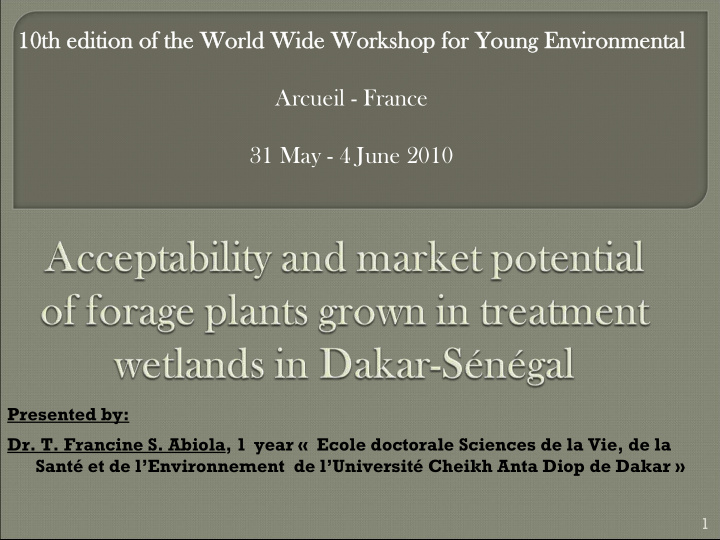



10th edition of the World Wide Workshop for Young Environmental 10th edition of the World Wide Wo rkshop for Young Environmental Arcueil - France 31 May - 4 June 2010 Presented by: Dr. T. Francine S. Abiola, 1 year « Ecole doctorale Sciences de la Vie, de la Santé et de l’Environnement de l’Université Cheikh Anta Diop de Dakar » 1
The treatment of faecal sludge in planted drying beds with Echinochloa pyramidalis offer many advantages: • an environmental and economic technology ; • solid-liquid separation and purifying sludge are important; • an production of nutriments to support agricultural production and improve livestock productivity while protecting the health of populations. 2
After the studies for Master aimed at assessing the potentials of sludge drying beds vegetated with Echinochloa pyramidalis (Lam.) Hitchc. & Chase for faecal sludge (FS) treatment who conducted at the Station of Cambérène from november 2008 to march 2009, This study aims to assess the safety and nutritional value of Echinochloa pyramidalis from the drying beds, social acceptability levels of farmers and consumers and the potential of its economic and financial adjustment. 3
1. : Conduct a market study on the recovery of forage grown in drying planted beds in urban and suburban; 2. : Evaluating the social acceptability of plants grown under artificial fodder by farmers and consumers; 3. : Analyze the effect of conditioning on the nutritional value and health (applying the method QMRA) Forage Echinochloa pyramidalis from drying beds planted and compare them to their natural ecosystem; 4. : Evaluate ways to optimize the treatment of sludge from the beds planted at the filer (Application of the material flow analysis) 4
• Faecal sludge(FS) is defined as sludge of variable consistency collected from so-called on-site sanitation systems, such as latrines, non-sewered public toilets, septic tanks and aqua privies. is derived from human excreta. • Planted sludge drying beds can be define as an artificial system composed of selected media supporting emergent vegetation purposely constructed by humans for sludge dewatering 5
V E N T I L A T I O N P I P E C A T T A I L S R A W F E R R O - C E M E N T S E P T A G E W A L L H O L L O W C O N C R E T E B L O C K D R A I N A G E P I P E P E R C O L A T E T A N K Source: AIT ‐ SANDEC 6
� Echinochloa pyramidalis is a reedlike perennial up to 300 cm high, with solid stems, rarely to 450 cm, ligules of the lower leaves a fringe of hairs often absent on the upper. Inflorescence 15-30 cm long with racemes up to 8 cm long having purplish, acute, awnless spikelets 3-4 mm long (Napper, 1965). Is particularly rich fodder for livestock both as green fodder and hay in tropical Africa. No toxicity has been reported. 7
Genus: Echinochloa Family: Poaceae (alt. Gramineae ) subfamily: Panicoideae tribe: Paniceae . 8
November 2008 March 2009 9
The study will be divided in two parts: one part experimental and other part socio-economic. The methodology used is based on "ecosystem approach to human health" or EcoHealth approach. Figure. 1. Ecosystem approach t (CRDI) 10
Experimental study Experimental study 1. Safety of Echinochloa pyramidalis by the Quantitative microbial risk assessment (QMRA): 4 stages � Hazard Identification: Describe a microorganism and the disease it causes � Dose-Response: The relationship between the dose (number of microbes) received and the resulting health effects � Exposure Assessment: Determine the size and duration of exposure by each pathway. Estimate the number of people exposed and the categories of people effected. � Risk Characterization: Integrate the information from steps 1, 2, and 3 into a single mathematical model to calculate risk -- the probability of an outcome like infection, illness or death. Since steps 1, 2 and 3 will not provide a single value, but a range of values for expsure, dose, and hazard, risk needs to be calculated for all values across those ranges. 11
2.Nutritional value of Echinochloa pyramidalis The nutrient content of forages varies greatly depending on the type of forage, degree of maturity at cutting and capacity preservation. Quantifies: � the energy from food and food needs , � the digestible protein in the intestine � The digestibility of forage. 12
Socio-economic study Socio-economic study � Evaluating the social acceptability of the use of Echinochloa pyramidalis by stakeholders a questionnaire applied and interview guidelines distributed according to the importance of the role in society of stakeholders. Both tools will be developed just after an observation phase. 13
� Conduct a market research and assess the economic viability of the use of byproducts of planted drying beds This activity will be done with the collaboration of the entire team. The test of acceptability, factor analysis and typological analysis will be performed. � Use Material flows analysis in the treatment of faecal sludge It uses Input/Output methodologies, including both material and economic information. It is an accounting system that captures the mass balances in an economy, where inputs (extractions + imports) equal outputs (consumptions + exports + accumulation + wastes), and thus is based on the laws of thermodynamics. 14
� Characterization of Echinochloa pyramidalis as forage: safety and nutrition values � Acceptability of Echinochloa pyramidalis by stakeholders � Economic values of Echinochloa pyramidalis in livestock in urban and peri urban area. 15
This project aims at linking sanitation service and infrastructure provision to cities economic development agenda. It links : (i) sanitation improvement and (ii) food security in poor urban and peri-urban areas of developing countries. Hence, this project introduces a new paradigm: making excreta and wastewater management a profitable business for cities planners and stakeholders. 16
Recommend
More recommend